Grasses that are grazed severely and often, not allowing sufficient time for recovery, will lose much of their roots. Remember the phrase “No shoots, no roots. No roots, no shoots”. Back to Figure 1, the grass on the far right of the accompanying picture is a prime example of a grass plant being grazed severely and often. On the far left is an un-grazed grass plant. I’ve seen un-grazed Rough Fescue choke itself out. Timely grazing and rest periods contribute to the plant’s health and longevity.
When grasses are grazed severely enough, part of the roots slough off as shown in Figure 5. These roots must be fully replaced before the next grazing for the plant to continue to be healthy and vigorous. This is a good thing to do occasionally as the sloughed off root material is an important source of soil organic matter. The important thing to remember is to allow sufficient time for the grass to reach late Stage Two or Stage Three after a severe grazing.
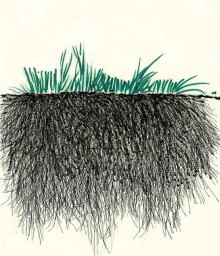
I think it’s important to clearly distinguish between severe grazing and over-grazing. Severe grazing is simply grazing a forage plant so as to remove most of the plant material above the soil surface. As long as the plant has sufficient TIME to fully recover to late Stage Two or Stage Three, it is NOT over-grazed.
Over-grazing can be defined as grazing a plant before it has had sufficient TIME to recover to late Stage Two or Stage 3. Time is the key element here. When over-grazing occurs over and over again throughout growing seasons and from year to year, we get a condition many people call root bound. This describes a condition in which we have a mat of roots at the soil surface with very little roots reaching deeper. I prefer to call this condition “root-less”.
Repeated over-grazing also compels forage plants to change growth habits to protect themselves from grazing. I first learned about this miniaturizing affect from Allan Savory over twenty years ago when I read his book “Holistic Resource Management.”
I see this condition often in my travels on pastures in Central Alberta. I see many forage plants that have pretty much “miniaturized” far below their species’ capabilities. Figure 6 shows just how small grasses and clover can get.
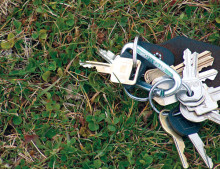
I also see many of these plants growing prone, so close to the ground that grazing animals have difficulty grasping them. Many desirable forage plants die out rather than subject themselves to such a meager existence and so we start seeing increasing patches of bare ground.
When grasses are grazed lightly (skim grazed) we don’t see the sloughing off of root material. These lightly grazed grasses recover very quickly, and here’s the kicker, will often “stool out” (increase in density) and significantly increase the volume of forage available from that growth cycle.
Grazing plans can be developed to take advantage of this phenomenon to increase pasture forage production. You would want to move the herd very fast during June growth, leaving most of the forage behind, and then slow down when growth slows. If done right the forage volume should increase significantly by the second and third grazing treatments. Remember: “Fast growth – fast moves, slow growth – slow moves”.
Another of my favorite phrases is “Nature hates a void.” When forage plants are miniaturized and eliminated from over-grazing, we start seeing invasive plant species move into their vacated spots. These plants tend to increase on over-grazed pastures because their growth habits protect them from grazing or they are unpalatable or poisonous to the grazing animal. On native pastures, many valuable agronomic forage species are considered invasive because they will readily replace native forages under over-grazing pressure. On tame pastures we don’t take it quite so far. We tend to welcome any plants that will enhance the diverse mix of palatable and nutritious forages available on our pastures.
We often see particular invasive plant species as indicators of pasture health problems often as a result of over grazing. In our west, central, Albertan environment, we often see species such as Yarrow or Wild Strawberry as indicators of over grazing. In dryer areas, Pasture Sage can be added to the list.
The important thing to remember is that the presence and increase of these kinds of species are symptoms of the real problem. There’s not much point in attacking the symptoms without addressing the real under-lying problem.
Time is the key to this. How long we graze and how long we rest the land. We’re talking about nature’s time, not calendar time. As we all know, nature’s time is never so rigid that we can predict nature’s events on our calendars. Right from the ‘get-go’ we should plan on adjusting our grazing plans as each season unfolds. Growth rates are highly variable and therefore you need to use variable flexible rotations.
Stock Density is a tool, and a handy one at that. Stock density refers to the number of animals divided by the number of acres in a given paddock within a pasture.
High stock density reduces selective grazing, thereby increasing uniformity of grazing which promotes uniformity of grass growth. It also promotes uniform distribution of manure and urine and increases herd impact (trampling, or hoof action and fouling), which contributes to the health and productivity of the pasture for future grazing. This is what you want happening on your pasture. Figure 7 shows a herd of 700 approximately 800 lb. yearling cattle waiting for their daily move. At about 10 acres per day, the stock density is 70 head per acre, or about 56,000 lbs. of beef per acre.
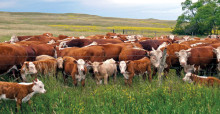
There is a certain point with every herd and every pasture where stock density works its magic. There is no magic number. It just comes by trial and error. By manipulating, either or both, herd size and paddock size, we can find that point for the different effects we want to see on the land.
I was recently reading an article by Greg Judy in the Stockman Grassfarmer where he wrote about some of his experiences with stock density. He found that at stock densities of 200,000 to 500,000 lbs of grazing animals, the pasture responded with increased production and health of the forage plants. The plants had a shiny dark green, lush appearance. He also
noticed that the yearlings he was grazing at the time preferred the forages in the areas where high stock density grazing had occurred during the prior year.
Now don’t get discouraged because you only have a few horses. While you might not be able to re-create the trampling effects of a large herd moving across the landscape, you can make enough difference to improve your pastures and make them more sustainable.
Stocking rate is simply the number of animals you have on a whole pasture. It is usually expressed in “animal units/acre” or “head /acre”. 1 animal unit = 1000 lbs of critter. Stock conservatively – use added forage production for a longer grazing season.
You can stock conservatively and use high stock density as a tool on your pasture as well. The herd you use would simply be used on a very small area at a time. Too high a stocking rate leads to too fast a rotation and therefore, controlled over-grazing. A good friend of mine called this “untoward-acceleration.” Rotational grazing at too high a stocking rate will damage a pasture as much as continuous grazing.
With the electric fencing technology we have available now, we can easily use permanent and portable electric fencing at a far lower cost than most any traditional fencing system. Flexibility can be built in quite easily and inexpensively. Strip grazing systems, in which one moves an electric fence frequently allowing livestock access to a narrow strip of fresh grass, are easily done with electric fencing. Figure 8 shows how electric fences can be used to make small paddocks.
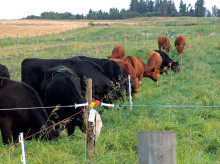
I used strip grazing to accomplish grazing three horses for eleven months on ten acres. During the growing season I moved a small watering trough along with the horses and followed behind with a back fence about three moves back so the horses had some room to move around. Once we were into the dormant season in the fall, I removed the back fence and allowed the horse to walk back to a heated waterer at the barn. Through the winter I moved the front fence no more than two feet per day. This gave the horses sufficient feed each day. All three horses stayed in excellent condition throughout the winter. By April I had used most of the stockpiled grass and then fed hay until I had sufficient new growth to start grazing again.
Water systems that are easily moved, and bring the water to the livestock, can really help to make your pasture infrastructure and grazing plan work for you. Figure 9 is an example of an easy watering trough for moving often. Figure 10 shows a neat portable hose reel. On the other hand, water systems in which the livestock must go to the water can make grazing management very difficult. High stock density grazing, nutrient distribution and herd effect are challenging to implement when paddock size and shape are limited by a central, or not so central watering station.
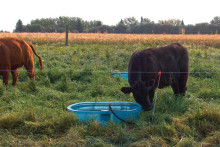

In larger pastures or pastures on rough terrain where cross-fencing into paddocks is difficult or not an option, placement of water, salt and minerals strategically can be used to get the livestock where you want them. Developing herding skills to the point where you can start, turn, stop and place your herd where you want can be a real asset on the larger spreads.
Our minds are the only thing that stops us from getting great results. The words “It can’t be done” on my place often stand in the way of success. I’ve never met a successful grazier that says “I can’t do that”. Be creative and you can do it.
So you’re intrigued by the idea, but don’t know where to start? If you’re located in Central Alberta, around the Red Deer area, you could have me come to your place and help you get started. If you live further away, we could use the phone and email to get the job done. I can be reached at the Grey Wooded Forage Association office at 403-844-2645, or you can email me at gwfa2@telus.net.

